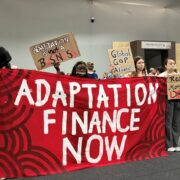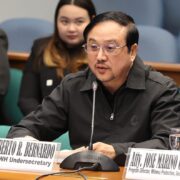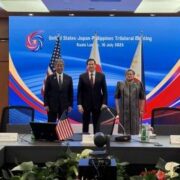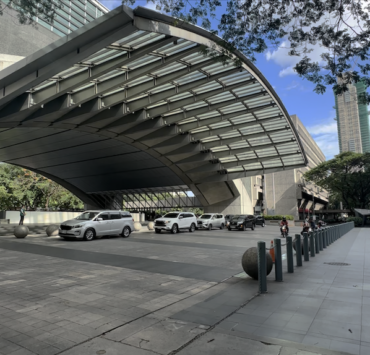‘Walang iwanan’: Words from Peta’s formidable ‘Tres Marias’

Before Beng Santos-Cabangon became the Philippine Educational Theater Association’s (Peta) executive director, her kumare Maribel Legarda remembers her saying, “If I take this on, walang iwanan.”
The two became part of the management committee together (with Santos-Cabangon in charge of overall management and Legarda overlooking the different creative programs of Peta) and have been a tandem since 1992.
Five years later, Legarda would take on the role of artistic director, and they would invite CB Garrucho to become president in 2004. Peta founder Cecile Guidote-Alvarez would dub the theater triumvirate the “Tres Marias.”
“With the three of us, it was like a shared leadership,” Garrucho told Lifestyle during a joint video conference. “The wonderful thing about us is there’s no turf guarding. Wherever one needs support, wherever one needs to be stronger, we meld into each other’s skills and contributions.
“It’s not to say that we’ve never disagreed at all,” she added. “Of course, we disagree. But in Peta, we’ve always got to be a team. Unless you’re a team, the task is too big—bigger than any one of us. So we’ve got to come together as a strong team. And that’s what the three of us have been.”
Peta announced the trio’s retirement late last year, followed by the revelation of a brand-new management team that will take over the theater company: Melvin Lee as president, Anj Heruela and Michelle Ngu-Nario as executive directors, J-mee Katanyag as artistic director, Norbs Portales as curriculum director, and Mitch Go as marketing director.
Legarda admits the young leaders will have huge shoes to fill: “I’m not saying this to brag, but with the resources we’ve left … With bigger resources come bigger responsibilities.”
The problems they were dealing with were simpler back then: lack of funds, lack of a permanent location. It was a different world.
Transition
Back when they were just starting out with their own leadership in the early 1990s, the world was undergoing transition. “The Philippines underwent many changes. Edsa (People Power) happened in ’86. There were so many global events that took place at that time, and when Maribel and I entered, Peta was also soul-searching,” said Santos-Cabangon. “We were coming from an experience of doing theater under martial law, pushing for a nationalist theater, etc. And then that world changed.”
But there were no rules, and no expectations. They just had to change their approach and were able to reinvent the theater activism of the ’70s and the ’80s into the kind of theater that they are now doing, which is in pursuit of theater for development. According to Santos-Cabangon, this new thrust was a creative response to the challenges of globalization.
She added that their type of theater “gives voices to those on the margins. It’s theater that will empower these people to participate in processes that would allow their voices to be heard, for them to become visible, and to assert for policies and reforms that could better inform the kind of development they want for themselves.
“And we took on human rights as our overarching theme from that time on up to now,” she said.
Under their watch, Peta finally achieved its long-held dream of having a permanent home with the opening of the Peta Theater Center in Quezon City, possibly making it the only private theater company that owns its own theater center.
Its 50th anniversary was bittersweet with the passing of beloved leader Soxie Topacio. Shortly after, the group received a Ramon Magsaysay award, given to individuals or groups who have exhibited generosity of spirit.
“What better compliment would you ask for?” said Santos-Cabangon. “It was really very affirming. It was a recognition of the work of Peta.”
Game changers
Just the past decade, Peta has come up with several out-of-the-box and game-changing local productions, reaching out to fresh audiences and giving rise to a new appreciation for not only Philippine theater but also its dynamic connection with original Pilipino music as well as Filipino films—most notably “Care Divas,” “Rak of Aegis,” “William,” and, more recently, “One More Chance, The Musical.”
Peta wasn’t the first theater company to do a jukebox musical (“Rak”), but the way Legarda put the play together proved to be extremely entertaining, and the kitschy growling tunes of the iconic local rock band resonated so much with the audience’s “hugot” over never-ending challenges that it went on to have a seventh season.
“You repeat something seven times because it was so good,” said Santos-Cabangon, adding that the musical expanded their audiences beyond what they had previously experienced.
It was evident from the number of producers and record labels that have been approaching them to offer their own catalogs of music “how existing music and theater can come together and come up with wonderful and profitable projects that people will talk about,” she said.
But “One More Chance, The Musical,” based on the 2007 movie starring John Lloyd Cruz and Bea Alonzo using music by Ben and Ben, took it a step further. The theater was already sold out two months before the play even opened—which had never happened in all 57 years of Peta.
Their success track was interrupted when the pandemic happened. During the three-year lockdown, theater was considered nonessential. They had neither performances nor income. “But it was also during the pandemic that I really saw how the organization could come together so that Peta would be able to weather the challenges of the pandemic,” said Santos-Cabangon. “And in our excitement, during the pandemic, during the lockdown, we were still so busy. We even held festivals online.”
Endowment fund
Garrucho was also grateful that they were able to build the Peta reserve fund or endowment fund, which was to be used for emergencies like the pandemic. “If we didn’t have that reserve fund, we wouldn’t have made it. But, thank God, we were plodding and plodding for over a dozen years to build that fund,” she said.
According to her, that fund is also part of the sustainability effort that Santos-Cabangon spearheaded.
“I think our greatest contribution really is making Peta sustainable,” said Santos-Cabangon.
“There’s no money in the arts, or it’s hard to earn in the arts,” added Legarda, so it was the biggest hurdle they had to go through during their tenure.
“When we became leaders, Peta was almost 100-percent dependent on funding,” said Santos-Cabangon. “So when funding was drying up, that was really the biggest challenge. ‘What is it that you can do that will allow you to sustain yourselves without having to be dependent on funding?’
“Of course, in the beginning we were so angry and told them, ‘You have no appreciation of cultural work!’—completely missing the point.”
But very slowly—and not without any difficulty or fights within the company—they were able to generate income to cover majority of their needs.
Peta’s sustainable challenge didn’t only concern the financial aspect, however. Their team made sure to make their operations more professional; address and improve further their financial management systems; set up their marketing and promotions arm; look for ways by which they could boost their income-generating capacities; and build the theater center.
New projects
Peta is more than just a theater company now. It has launched several projects including the ARTS Zone Project or Advocate Right to Safety Zone for Children Project, which is a campaign promoting children’s rights to safety and protection from any form of violence and abuse; the Kalinangan Ensemble (KE), the repertory arm of Peta, comprised of artist-teachers who design out-of-the-box theater seasons that challenge critical thought and expression; the Peta Lingap Sining Program, a campaign promoting the culture of safety and resilience in Philippine communities; the School of People’s Theater, the training arm of Peta; and the Theater Center Program Unit, a cultural hub used for hosting various events.
“Peta is quite sustainable now but, yes, every year is a challenge,” added Santos-Cabangon.
Asked if they were worried about the void they were leaving, the former executive director said, “I wouldn’t call it worry, but all transitions are never easy.”
“We inherited from the early generation the curriculum, the pedagogy, the aesthetic practice, and we tried to evolve that,” said Legarda.
“We have to hand it to the founder, Cecile Guidote, who founded and had the original vision for Peta. And what we did was to build on the vision, on the plan that she had established. And so we nurtured that vision depending on the context of our time,” added Garrucho.
What the next generation of Peta leaders will be inheriting from them is a very visible Peta, with its own building and pool of resources. “They won’t have to worry about that. But we recognize the level of pressure on them,” said Legarda.
“They have resources, but they should be able to manage and grow these resources so that they can be sustainable for a very long time,” added Santos-Cabangon.
“You know, that work has been the work of many generations, not just us—one generation building on the work of the one that came before. So it’s like building blocks. And that’s why we’re so sure the young generation will build on the blocks that we had formed,” said Garrucho.
Succession plan
Not to worry, though, as the succession plan had been in the works for about 10 years (although they were only able to actively jumpstart the process two years before the pandemic).
For the succession plan, they organized a study group among possible future leaders of Peta where they discussed issues to try to understand what was happening in the country and the world; new trends in the practice of arts and theater; and they would even invite them to provide input to the management committee and general assembly on occasion.
According to Santos-Cabangon, the group looked into the different facets of leadership, management, human resource development, understanding finances, marketing.
During the pandemic, they requested most of the possible candidates to spearhead the process of revisiting the company’s vision and mission, which gave them a broader picture of Peta.
And, finally, upon the election of Lee as president, when he also appointed his artistic director, curriculum director, and confirmed the appointment of the executive director, they also started shadowing their predecessors for about six months.
“And this new generation of leaders is going to get into something that’s not quite new, but at the end of the day, once you’re at the helm of it, it is still new,” said Santos-Cabangon. “You really only begin to understand what it means to lead Peta when you’re actually doing it. We have high hopes that they will be able to deliver.”
The trio have a common wish for Philippine theater, and that is for a “thriving, living and meaningful and relevant theater with a big audience base, with a lot of supporters and not only city-centered or Metro Manila-centered, but all over the country.”
“My dream is for the audience to grow and grow and grow,” shared Garrucho. “I wish the school principals could realize that theater can be really a powerful tool for students to learn, to augment learning. I wish we had a Filipino audience that considers going to the theater to be like taking deep breaths of air, Filipinos who make going to the theater a habit.”
Santos-Cabangon added to her wish “a very strong art education program—because you really have to start with young kids.”
“There are just so many stories out there. I hope we get to tell them,” said Legarda, adding her hope to get help from the government. “The arts really need support because sometimes it really becomes also such a burden for us. So it would be great if sometimes the challenges of the art community can be alleviated by real subsidy from the government.”

















